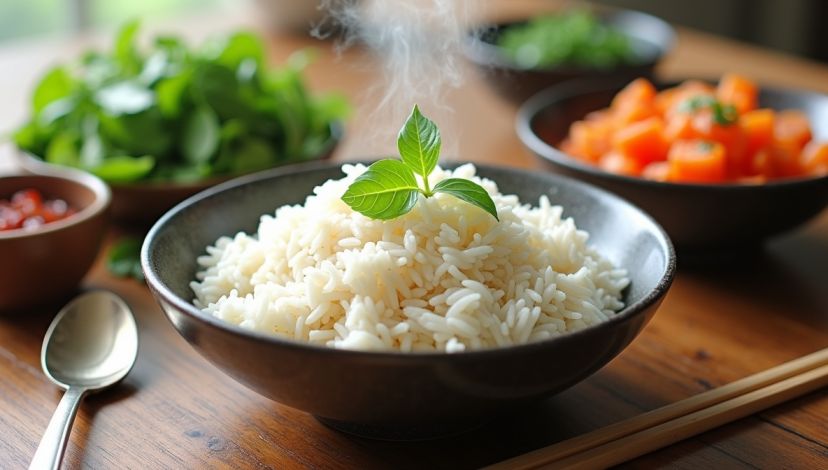Jasmine Rice Nutrition Facts: Discover the Truth For Your Health

Jasmine rice is famous in the kitchens of every country it is very tender, pleasant aroma, delicious; it can be used in more or less in all the dishes. Use in stir-fries, curries, or by itself as a simple side dish, this aromatic long-grain rice is the dish that is bound to bring comfort and satisfaction to the table. But with wellness top of mind for many, understanding the real jasmine rice nutrition facts is essential for making informed choices about your daily meals.
Table of Contents
- What are the Nutrition Facts Of Jasmine Rice?
- In one average (cooked up to 150g) serving of white jasmine rice, you will be posting:
- Use Case:
- Type of Jasmine Rice vs. Other Varieties: In comparison, how does it rate?
- Expert Insight:
- Benefits of Brown jasmine rice: A closer insight into whole grains
- Real-Life Example:
- Research Finding:
- Is Jasmine Rice Healthy? Advantages and Pros and Cons
- Expert Opinion:
- Considerations:
- Quick Tip:
- Food Planning, Cooking Hints, and Serving Fads
- Cooking Guide/Table Comparison Nutrition End Result
- Case Scenario:
- Jasmine rice eating patterns: World view and prospects in the future
- Top Data Trends:
- Action Step:
- Conclusion
- FAQs
In the modern health-conscious society, a portion of rice may evoke critical interrogatives on the amount of calories, amount of carbohydrates, amount of proteins, and the contribution of micronutrients. So, is jasmine rice empty calories, or does it have more to offer? How does it fare in comparison with other forms of rice? And what are you supposed to expect in selecting jasmine rice to your family? This article puts these questions to rest with facts on the ground, practical advice, and reputable expertise.
Key Points:
- Jasmine rice is a healthy type of carbohydrates that is tasting and smells uniquely.
- Various types (white jasmine rice and brown jasmine rice) possess different nutrition values and benefits.
- Understanding jasmine rice nutrition facts empowers you to make healthier meal decisions.
What are the Nutrition Facts Of Jasmine Rice?
The nutritional content of jasmine rice, and in particular, the popular white type, is simple in nature: it is rich in carbs, moderate in calories, and extremely low in fat and sodium content. The knowledge of these nutrition facts enables you to consume jasmine rice reasonably in your diet.
In one average (cooked up to 150g) serving of white jasmine rice, you will be posting:
- Calories: 200 kcal
- Carbohydrates: 46g
- Protein: 4g
- Fat: less than 1g
- Fiber: 1g or so
- Sugar: 0g
- Calcium: 19.5 mg
- Iron: 1 mg (11 percent DV)
- Sodium: 0 mg
These figures are attributed to jasmine rice being an energy staple, as it contains a lot of carbohydrates. Although containing a low proportion of fat, jasmine rice is a high-calorie source of food based on its serving capacity, which facilitates body energy, especially in excessive activities or in instances with a hectic day.
Use Case:
The jasmine rice is frequently prescribed by registered dietitians to athletes or people who require instant energy consumption before and after heavy exercise. This is a favored food in pre-event foods since it is easily digestible.
NB: the amounts of the nutritional labels vary a little with different brands and between whole wheat and white, so be sure and check.
The slight distinction between white and brown jasmine rice gains significance when one is to take into consideration the effects that they have on blood sugar and satiation, which is explained in further paragraphs.
Type of Jasmine Rice vs. Other Varieties: In comparison, how does it rate?
The fans of rice have numerous options to choose between, and each of them can be both beneficial and harmful and nutrition-wise. The following is a detailed comparison of a white jasmine rice, brown jasmine rice, and normal white rice to make the best decision on what is good to your health.
| Type of Rice | Calories (per 150g cooked) | Carbohydrates | Protein | Fiber | Fat | Iron | Glycemic Index |
| White Jasmine Rice | 200 | 46g | 4g | 1g | <1g | 1mg | High (~80) |
| Brown Jasmine Rice | 170 | 34g | 3–4g | 2g | 1–1.5g | up to 2% DV | Medium (~60) |
| Regular White Rice | 129 | 28g | 2.8g | 0.7g | 0.46g | — | High (~77) |
Table Caption: Calorie and carb count in jasmine and common rice types (ALT text: Table containing the calories, carbs, fiber, and more relevant to jasmine rice and other common rice types).
Expert Insight:
Medical News Today states that brown jasmine rice contains more fiber, more micronutrients, and a reduced glycemic index with comparison to white rice. Although the source of fiber is moderate, it helps with digestive regularity and long-lasting satiation.
Brown jasmine rice or any other whole-grain type has long-term advantages in the case of persons living with blood sugar or people who prefer to consume more fiber.
Benefits of Brown jasmine rice: A closer insight into whole grains
Less processed jasmine rice, e.g., brown type, is a whole grain and contains not only all the nutritious elements of its germ and bran structure, but also a higher concentration of those elements. It is more of vitamins, more of minerals, and more of dietary fiber in a serving, which is significant in a balanced diet.
- Brown Jasmine Rice (win 1 / 4 cup cooked)
- Calories: 160
- Carbohydrates: 36g
- Protein: 3g
- Fat: 1g
- Fiber: 2g
- Iron – 2 per cent of the daily value
- Thiamine B vitamins: (10 % DV), Niacin (15 % DV).
Real-Life Example:
Linda, a wellness coach and vegetarian, cut out using white jasmine rice in her family meals and replaced them by brown jasmine rice in order to have more fiber and constant energy. She said she feel more regular digestion and less energy crash in the late afternoon, reported the same to her client.
Phytonutrients also offer antioxidant effects which are beneficial to the health, and these phytonutrients are found in whole grain varieties, and among these are red, purple, and black jasmine rice.
Caution: Brown rice may be an acquired taste, and newcomers are advised to take their time gaining access to it and have it with some strong-tasting sauces or vegetables so that children can easily accept it.
Research Finding:
According to Healthline, similarly to all whole grains, brown jasmine rice will also provide long-lasting fullness as well as be able to aid in healthy blood sugar control compared to white rice, which will digest faster and could lead to spikes.
Is Jasmine Rice Healthy? Advantages and Pros and Cons
The notion of jasmine rice being a healthy food has to do with personal health objectives, athe mount served, and the kind of Jasmine rice. Evidence-based benefits and considerations appear as follows:
Benefits:
- Energy Source: It has high amounts of carbohydrate, thus it is useful as a source of energy.
- Low Fat & Cholesterol: A perfect ingredient for a heart-healthy diet.
- Sodium and Gluten Free: Suitable to individuals with special dietary requirements such as the low sodium or gluten-free foods.
- Vitamin and Minerals: Brown jasmine rice contains B vitamins, magnesium, and manganese.
Expert Opinion:
A clinical dietitian observes that Jasmine rice is a convenient source of food for the body, particularly when combined with protein and vegetables. Specifically, brown jasmine rice promotes digestive health and regulates consistent blood sugar.”
Considerations:
- The glycemic index of white jasmine rice is high, meaning that it is fast to digest and is not ideal in individuals with high blood sugar or those requiring slow-release carbs.
- Every rice is susceptible of some amount of arsenic, not to mention the use of such rice day after day. That is why the FDA suggests that you should change your grains.
- Watch your portions, and although rice of all kinds is healthy in small amounts, there is such a thing as too much of a good thing; once you get it in addition to a whole lot of carbs or calories.
Quick Tip:
Combine jasmine rice with lean protein and generous vegetables to form a balanced meal that will sustain your body with energy without causing blood sugar spikes.
Food Planning, Cooking Hints, and Serving Fads
Jasmine rice makes the ideal meals when it is chosen and prepared to give maximum nutrition. Such practical recommendations and sensible suggestions as follows can be offered by culinary professionals:
- Clean Thoroughly: The first step is to rinse or clean jasmine rice, which removes some of the starch to make the rice more fluffy, and it also reduces the presence of arsenic to some extent.
- Eat Whole Grains Regularly: Replace white or plain jasmine rice with more nutritious brown colored or a healthier version of the same.
- Portion Awareness: It’s commonly served as 1/2 to 1 cup of cooked rice per person — a reasonable and practical portion size.
- Flavor Smart: Jasmine rice is great in Thai curries, grain bowls, and under the protein-rich stir-fry and salads. Its nice scent can be utilized in selling healthy food to fussy eaters.
Cooking Guide/Table Comparison Nutrition End Result
| Cooking Method | Texture | Nutrition Impact | Best Use Cases |
| Boiling/Steaming | Fluffy, soft | Preserves most nutrients | Curries, stir-fries |
| Pilaf/Sauté (with oil) | Slightly firm | Adds some fats, bolder flavors | Rice bowls, pilafs |
| Pressure Cooking | Very soft | Minimal loss of nutrients | Batch cooking, speed |
Table description: Popularly used ways to cook jasmine rice, and the nutritive and culinary benefits attached to the rice varieties (ALT text: Table that shows modes of cooking jasmine rice and benefits attached to them in terms of nutrition and cooking).
Case Scenario:
I explain to the clients who seek my assistance as a nutrition coach that they should incorporate whole-grain jasmine rice into Mediterranean diets by crafting delicious bowls from grilled vegetables, chickpeas, and a squirt of lemon.
Tips: Sauces or oils should be added sparingly, as an extra portion of calories may be obtained within a very short period.
Jasmine rice eating patterns: World view and prospects in the future
The consumption of Jasmine rice is increasing in other parts of the world and is known to have a good aroma as well as being soft and flexible in the world cuisines. Due to the increased interest of more people in healthier food, brown and colored varieties of jasmine rice are gaining popularity due to the support of culinary trends and consumer education of the benefits of healthier food.
Top Data Trends:
- In more than 100 nations, jasmine rice is used as a primary staple, which plays an important role in global energy and carbohydrate consumption.
- In the case of a high whole grain diet, such as brown jasmine rice, there is growing evidence on its connection with reduced heart disease, obesity, and some muscle cancers.
- To chefs and other culinary professionals, jasmine rice is well-loved due to its universal appeal, and in fusion cuisine, consumers desire the combination of both the experience and the health angles.
Action Step:
The Health organizations, the Academy of Nutrition and Dietetics, among others, insist that whole grains remain to be a basic component of daily nutritional values. Including brown jasmine rice into your weekly meal plan is beneficial to your health as well as your culture.
Note: White jasmine rice should not be completely excluded, but understand that by searching whole-grain sources, you can acquire an even bigger health benefit in the long term.
Conclusion
Jasmine rice nutrition facts shine a light on this beloved, aromatic grain that graces millions of tables every day. Jasmine rice is a high-carbohydrate nutrition powerhouse with an adequate foundation of protein and micronutrients, a highly stable source of energy, especially deserving in sports and developing families. Choosing brown jasmine rice, you will not only enjoy the taste, but also useful dietary fiber, B vitamins, and healthy antioxidants to assist you in leading a healthy life throughout it.
Key Takeaways:
- Focus on varieties enriched in whole grains, such as jasmine, as well as nutrients and carbs that are slower-digesting.
- Never eat too much or too little of your grains; have a decent, diversified diet.
When planning your next meal, let your new knowledge about jasmine rice nutrition facts help you make confident, healthy choices. In a calorie-controlled diet, just replace plain or white bread with brown or colored types and see the difference in your energy levels, concentration, and satisfaction meal after meal.
For more meal planning advice and healthy eating tips, check out our guide on White Rice vs. Brown Rice: Which One Is Healthier?.
FAQs
Q1: Which nutrients are contained in jasmine rice?
A: Jasmine rice is mostly carbs, with a little protein, a trace of fat, and a tiny proportion of building blocks such as iron and magnesium.
Q2: What are the calories in a jasmine rice serving?
A: There are approximately 200 calories in one 500 g cooked serve of white jasmine rice; brown jasmine rice has a little bit less per serving.
Q3:Is jasmine gluten-free rice?
A: Yes, jasmine rice is naturally free of gluten, non-hallucinatory, and suitable to celiac or people with gluten intolerance.
Q4: Is the white jasmine rice healthier than the brown one?
A: Brown jasmine rice is more healthy as they have more fibers, vitamins, and minerals than white rice.
Q5: Does jasmine rice spike blood sugar?
A: The glycemic index of white jasmine rice is high, and it is possible that it can significantly increase the level of blood sugar; therefore is advisable to switch to brown or whole-grain varieties in order to have a more controlled blood sugar level.
Latest Posts
You Might Also Like

Chipotle Nutrition – Your go-to guide for calories, healthy choices, and balanced meals at Chipotle.
TOP NEWS
© Copyright 2025 Chipotle Nutrition. All rights reserved














No Comments